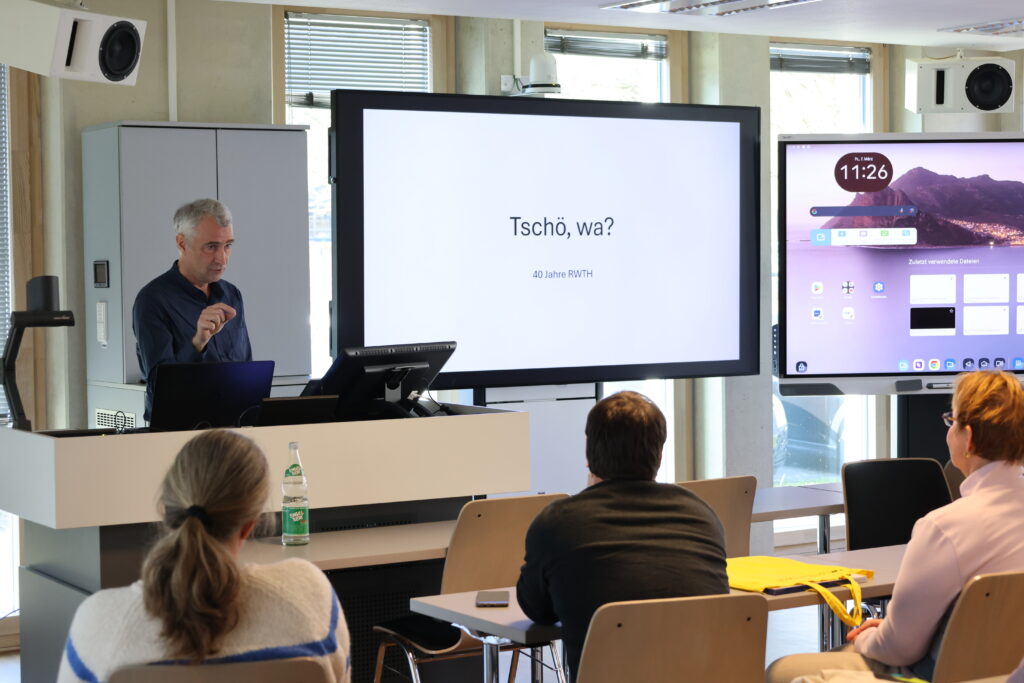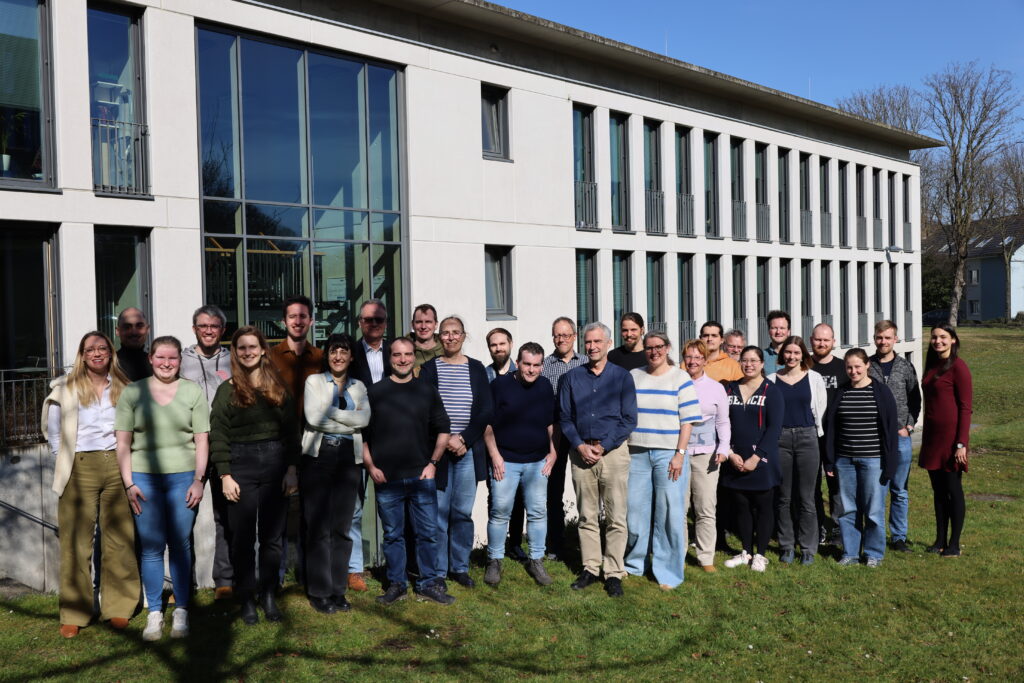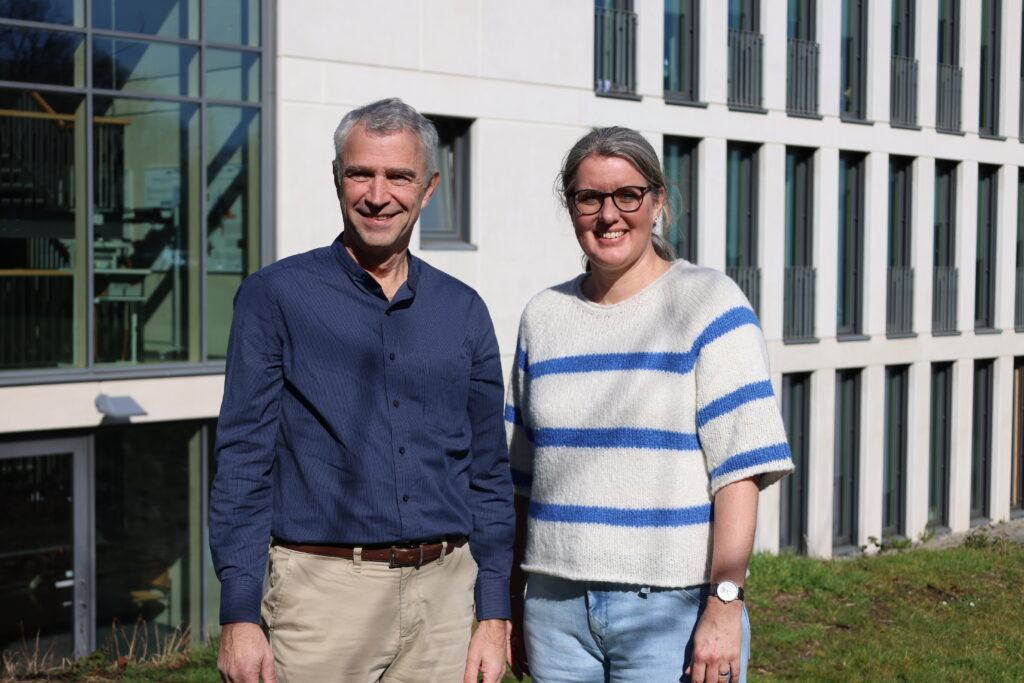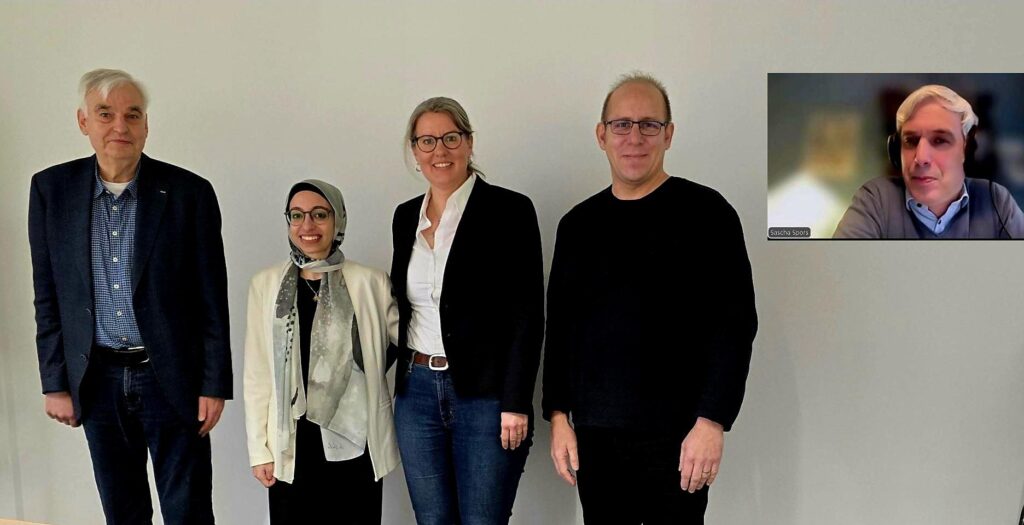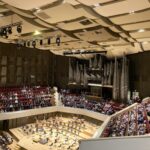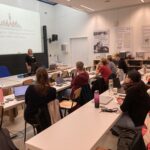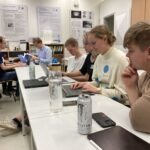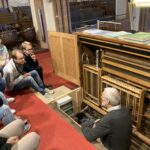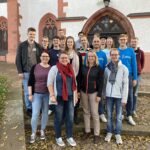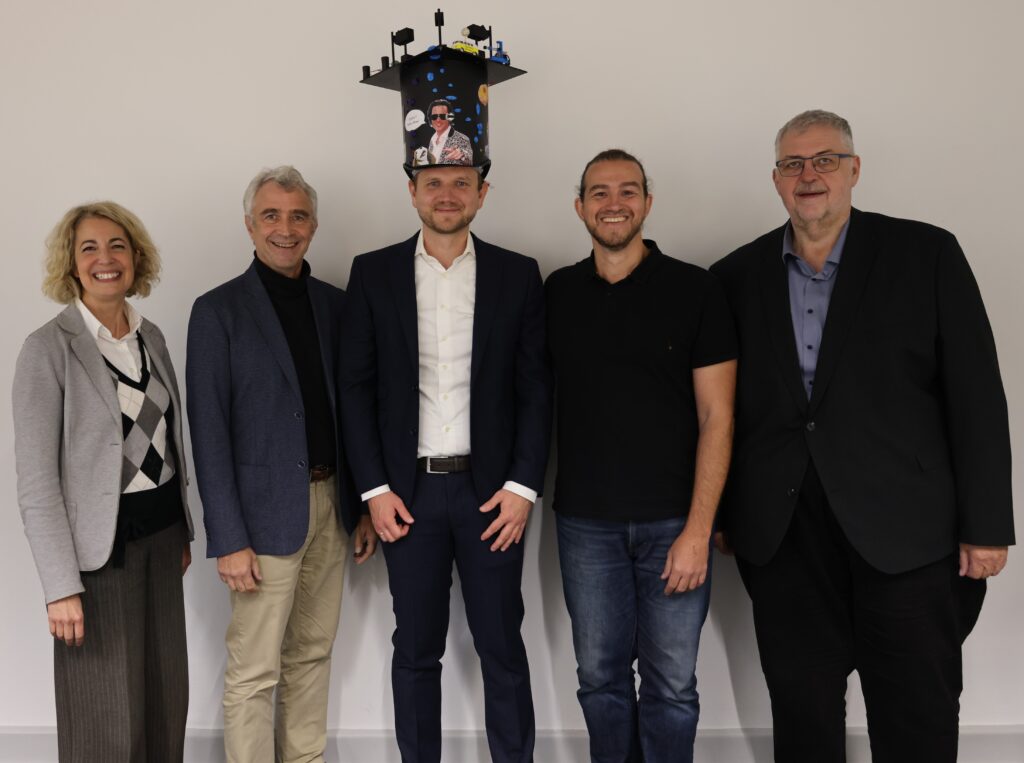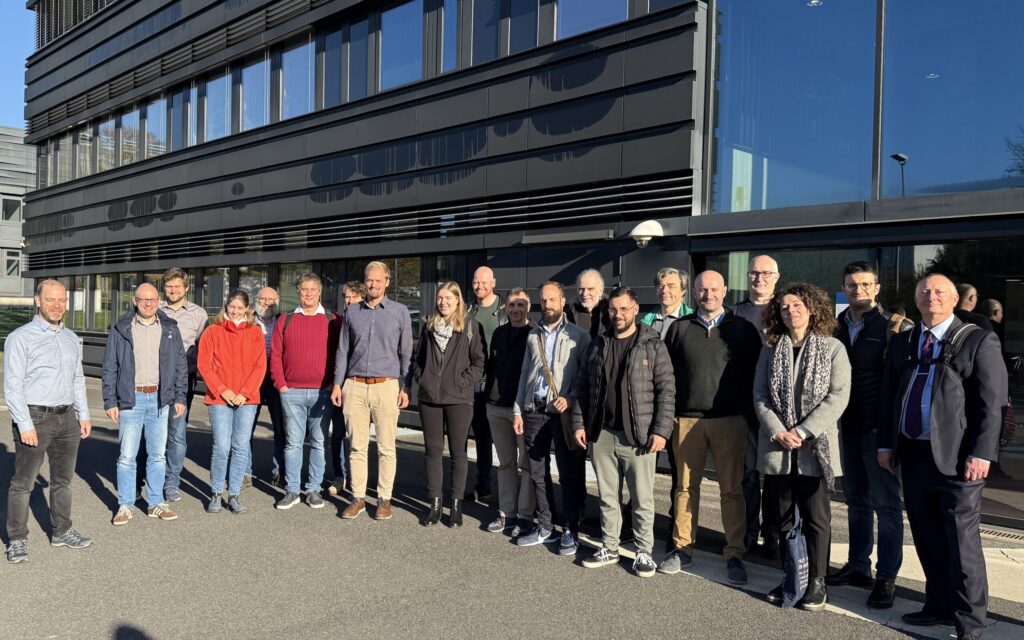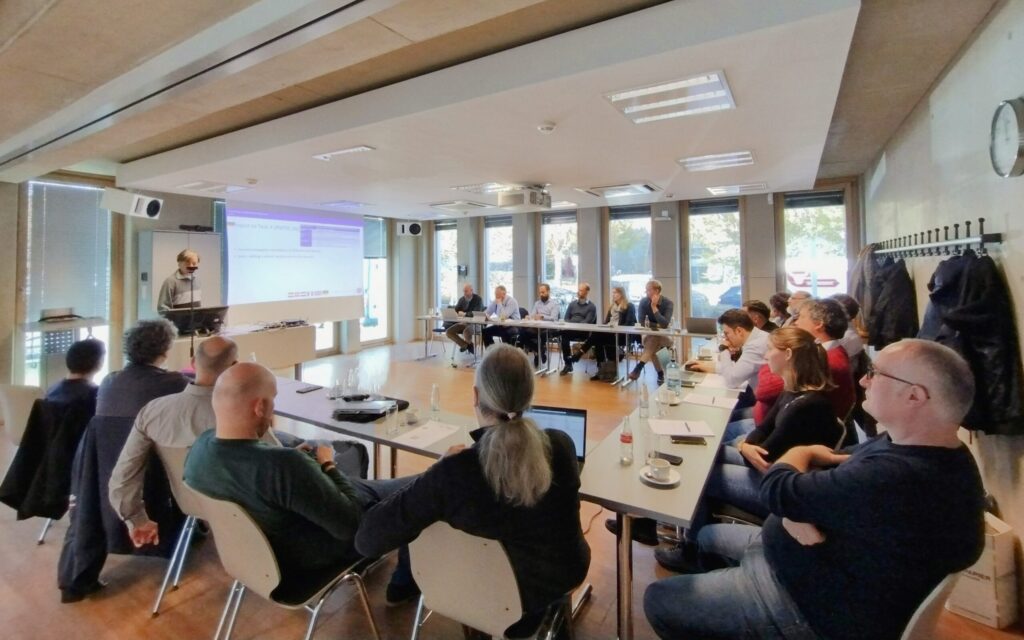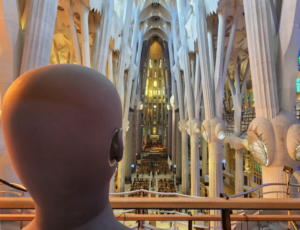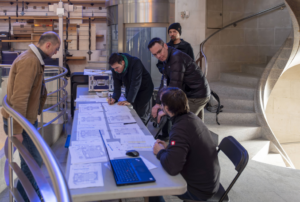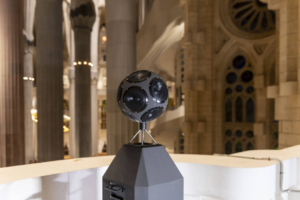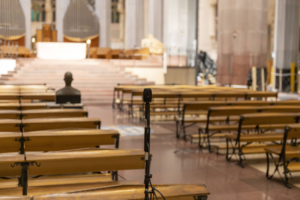Kategorie: ‘IHTA’
IHTA at Forum Acusticum Euronoise 2025 in Malaga
At the end of last month, the scientific conference Forum Acusticum Euronoise successfully took place in Malaga, Spain, organized by members of the Spanish Acoustics Society (SEA). Across four days, a total number of 1250 delegates participated and presented interesting research results in the field of acoustics and noise, accompanied by an engaging social program. The Institute for Hearing Technology and Acoustics was represented by Lukas Aspöck and our former colleague Marco Berzborn, who altogether organized three technical sessions and contributed to five papers:
- Marco Berzborn and Michael Vorländer: Stochastic Variational Inference of Directional Decay Times in a Reverberation Room
- Lukas Aspöck, Michael Vorländer and Janina Fels: Rendering complex acoustic scenes for perception experiments
- Marco Berzborn and Michael Vorländer: Analysis of the relationship between sound field isotropy and errors in the results of Sabine’s absorption coefficient
- Lukas Aspöck, Pascal Palenda, Janina Fels and Michael Vorländer: Application of room acoustics simulation software in university teaching
- Fabian Brinkmann, Marco Berzborn, […] Anne Heimes, Simon Kersten, Pascal Palenda et al.: Open educational resources for acoustics and audio signal processing using Jupyter notebooks and pyfar
- Entrance of conference venue in Malaga
- Opening on Monday: Plenary lecture on underwater sounds by Ana Sirovic
- IHTA alumni group picture
- Marco Berzborn during one of this presentation
IHTA at ICA/ASA Meeting in New Orleans
From May 18 – May 23, 2025, the 188th Meeting of the Acoustical Society of America (ASA) joint with the 25th International Congress on Acoustics (ICA) takes places in New Orleans, Louisiana. Seven IHTA members have traveled to the USA in order to present their latest research and to meet the international acoustics community. The following presentations will be given with contributions from our institute:
Cosima Ermert, Andrea Bönsch, Torsten Kuhlen, Janina Fels: The impact of coverbal visual cues on speech intelligibility and cognitive load in virtual reality environments
May 20, 1:40 – 2:00 pm (UTC -5), Location: SALON F/G, Presentation Number: 2pPP3
Julia Seitz, Janina Fels: How do classroom activities influence noise levels and student’s listening effort?
Poster Session, May 20, 1:20 – 4:20 pm (UTC -5), Location: STUDIO FOYER/STUDIOS 1-4, Presentation Number: 2pSC13
E.K. Ellington Scott, Lukas Aspöck, Herbie Klinger, Michael Vorländer, Jillian Willis, Jonas Braasch: A database of anechoic modern-jazz recordings for auralization
May 20, 3:20 – 3:40 pm (UTC -5), Location: GALERIE 6, Presentation Number: 2pMUa4
Simon Kersten, Henning Taschke, Michael Vorländer: On the sound pressure distribution in the inner ear during bone conduction stimulation
May 22, 1:00 – 1:20 pm (UTC -5), Location: SALON F/G, Presentation Number: 4pPPa1
Jonas Heck, Ronny Roos, Josep Llorca-Bofí, Michael Vorländer: Complex surface impedances and spherical wave approximations in image source models for outdoor auralization
May 23, 1:20-1:40 pm (UTC -5), Location: GALERIE 5, Presentation Number: 5pNS2
You can find the full conference program and abstracts on the website https://acousticalsociety.org/new-orleans-2025/.
We are looking forward to meet you in New Orleans!

Research results on acoustic directivity patterns of road-traffic vehicles
In the Journal of the Acoustical Society of America (JASA), a research paper by our former research assistant Christian Dreier and Prof. Michael Vorländer was recently published: Speed-dependent directivity patterns of road-traffic vehicles.
This paper explores the spatial and speed-dependent directivity patterns of various road-traffic vehicles, including electric, hybrid, and combustion-powered models. By employing time-variant wave backpropagation on microphone array signals, the research reveals significant insights into how driving conditions and engine characteristics influence vehicle noise emissions. The findings are compiled in an open-access database (http://doi.org/10.5281/zenodo.14142914), providing valuable data for noise mapping and auralization applications. The main parts of this research was supported by the HEAD-Genuit Foundation.
More details of Christian’s research will also be presented at his PhD defense, which will take place end of July 2025.
We’re happy that one of the paper’s figure was also chosen to be featured on the title page of the JASA’s current issue.

Title page of JASA, Volume 157, Issue 4
Wahlergebnisse der Deutschen Gesellschaft für Akustik
Die Deutsche Gesellschaft für Akustik e.V. (DEGA) ist ein gemeinnütziger Verein mit fast 2000 persönlichen Mitgliedern und aktuell 73 Fördermitgliedern (hauptsächlich Firmen mit Akustik- oder Lärm-Bezug). Die DEGA stellt den Dachverband für Akustiker*innen im deutschsprachigen Raum dar und vereint Mitglieder sowohl aus der Wissenschaft als auch aus der Praxis & Industrie, und richtet die jährlich stattfindene DAGA-Tagung aus.
Bei den kürzlich stattgefundenen Wahlen hat der Vorstandsrat der DEGA verschiedene Vorstandsmitglieder neu bzw. wiedergewählt, darunter wurde Prof. Dr.-Ing. Janina Fels als Vizepräsidentin und damit auch als designierte Präsidentin der DEGA gewählt. Herzlichen Glückwunsch zu dieser Wahl!
Prof. Dr. Stefan Becker von der Friedrich-Alexander-Universität Erlangen wird das Amt des DEGA-Präsidenten (von Prof. Dr. Sabine Langer) übernehmen und wird nach drei Jahren von Janina Fels abgelöst, die das Amt der Präsidentin ab 2028 ohne weitere Wahl für drei Jahre übernimmt.
Darüber hinaus scheidet unser ehemaliger akademischer Direktor, Gottfried Behler, als Schatzmeister bei der DEGA aus und wird von Christian Koch abgelöst. Wir danken Gottfried sehr für sein großes Engagement als Schatzmeister bei der DEGA.
Der Zeitpunkt der Amtsübergaben ist der 1. Juli 2025. Weitere Details und neu gewählte Vorstandsmitglieder finden sich in der entsprechenden Mitteilung auf der DEGA-Website.
Paper published: Cross-modal congruency modulates evidence accumulation, not decision thresholds
We are happy to announce that our paper „Cross-modal congruency modulates evidence accumulation, not decision thresholds“ was published as part of the Research Topic „Crossing Sensory Boundaries: Multisensory Perception Through the Lens of Audition“ in Frontiers in Neuroscience.
In this study, we collaborated with Björn Kampa from the Systems Neurophysiology Department of the Institute of Zoology here at RWTH Aachen University, and Christoph Kayser from the Department of Cognitive Neuroscience at Universität Bielefeld. We explored how audio-visual stimulus pairs—linked either by co-occurrence or by shared meaning—affect behavior and brain activity during decision-making.
By combining behavioral data from a decision-making task with brain activity measured via electroencephalography (EEG), we found two key stages that shape perceptual decisions: an early, sensory-driven stage, and a later, decision-related stage. Interestingly, whether the stimulus pairing was expected in terms of co-occurrence or meaning played a major role in how these early and late components contributed to the decision-making process.
Paper published: Activity-based acoustic situations in primary schools
We are happy to share a new publication by Julia Seitz and Janina Fels. Their journal paper „Activity-based acoustic situations in primary schools: Analyzing classroom noise and listening effort“ was published in the Journal of the Acoustical Society of America.
The publication introduces the concept of „activity-based acoustic situations“ in primary schools, shedding light on the everyday sound environment in classrooms.
Key findings include that different classroom activities result in significantly different noise levels, that noise levels decrease as students age—first graders experience higher levels than fourth graders—and that subjective listening effort does not differ significantly between activities. The results highlight the importance of activity-based assessment of classroom noise to create optimal learning environments.
Promotionsstelle (100 %) im Graduiertenkolleg „Akustisches Wohlbefinden im multi-domänen und kontextabhängigen Raumansatz (MOSAIC)“
Das Graduiertenkolleg MOSAIC (Akustisches Wohlbefinden im multi-domänen und kontextabhängigen Raumansatz), das von der HEAD Genuit-Stiftung finanziert wird, zielt darauf ab, unser Verständnis von „akustischem Wohlbefinden“ zu verbessern. Das Projekt untersucht, wie sich das akustische Wohlbefinden in verschiedenen Innen- und Außenräumen und bei unterschiedlichen Aktivitäten wie Lernen, Arbeiten oder Entspannen verändert. Es soll auch einen Beitrag zur Soundscape-Forschung leisten, die andere Umweltfaktoren und ihren Einfluss auf unsere auditive Wahrnehmung beschreibt.
Für dieses innovative und interdisziplinäre Projekt, das sich auf den akustischen Komfort in Lern- und Arbeitsumgebungen konzentriert, suchen wir engagierte Doktorand*innen.
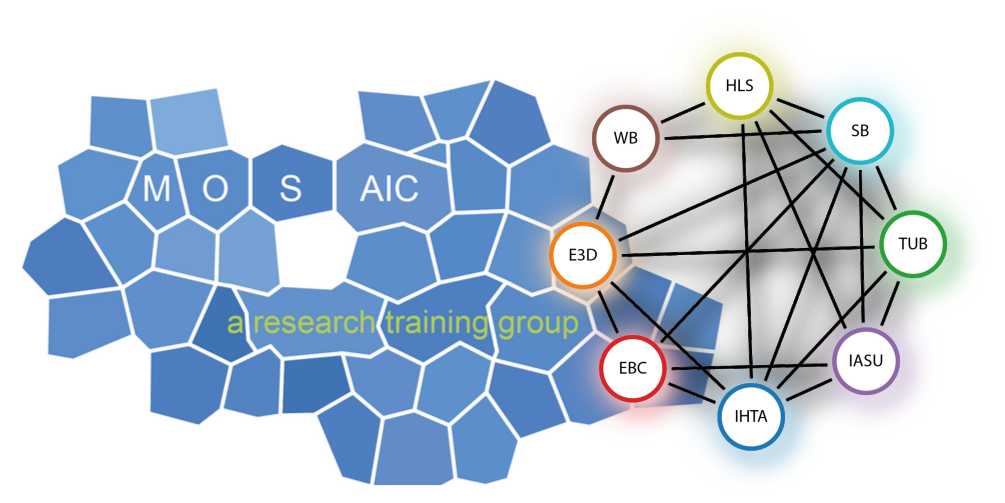
Unser Ziel ist es, einen umfassenden Ansatz zu entwickeln, der alle vier Hauptkomponenten der Innenraumumweltqualität (IEQ) – thermischer Komfort, Akustik, Luftqualität und Beleuchtung – integriert. Das IHTA bearbeitet dabei die Frage, wie virtuelle Akustik und VR für Komfort-Untersuchungen eingesetzt werden können.
Alle Einzelheiten zur Stelle am IHTA finden Sie hier:
https://www.rwth-aachen.de/go/id/kbag/file/V000009195
MOSAIC_RTG_PhD_RWTHAachenUniversity
Wir freuen uns auf Ihre Bewerbung!
Michael Vorländer tritt in den Ruhestand ein
Nach einer langjährigen Phase intensiver Forschung im Bereich der akustischen virtuellen Realität und der technischen Akustik ging Michael Vorländer am 28. Februar 2025 nach fast 30 Jahren als Professor für Technische Akustik an der Rheinisch-Westfälischen Technischen Hochschule (RWTH) Aachen offiziell in den Ruhestand.
Trotzdem ist er weiterhin aktiv an laufenden Projekten und Dissertationen am Institut für Hörtechnik und Akustik (IHTA) der RWTH Aachen beteiligt. Darüber hinaus wird Vorländer neben seinen Beiträgen zur Akustik-Community auf nationaler Ebene auch weiterhin eine aktive Rolle auf internationaler Ebene spielen, und zwar als Präsident der Acoustical Society of America von Mai 2025 bis Mai 2026.
Heute haben wir ihn im IHTA mit einer kleinen internen Abschiedsfeier und einem goldenen Doktorhut verabschiedet. Michael Vorländer hat der Akustik-Community, insbesondere dem IHTA, einen bedeutenden Beitrag geleistet!
Wir danken ihm von Herzen für seine Arbeit und wünschen ihm für seinen neuen Lebensabschnitt alles Gute.
- Abschiedsworte
- Goldener Doktorhut
- IHTA Team
- IHTA Leitung
IHTA Contributions to DAS|DAGA 2025
This year’s DAS|DAGA 2025 is the joint annual meeting of the Danish and German Acoustical Societies (DAS and DEGA). The conference takes place in Copenhagen from 17th to 20th of March, 2025. As usual, IHTA members will present their work on the plethora of research topics covered at IHTA. This year, the IHTA is involved in a total of 23 contributions. In addition, the IHTA has been very active in organizing special sessions and events (see below).
We are happy to invite you to our presentations and posters!
You can find the full conference program in the DAS|DAGA Web-App. Every contribution in the table below links to its entry in the web-app, where you can read its abstract and add it to your personal conference schedule.
We are looking forward to meet you there!
| Monday, March 17 | ||||
| Simon Kersten, Michael Vorländer | Physical Mechanisms Underlying the Occlusion Effect | Precolloquium: Hearing Acoustics: Models, algorithms and applications | 12:25 | Room 20 |
| Tuesday, March 18 | ||||
| Rouben Rehman, Simon Kersten, Janina Fels | An Experimental Setup for the Estimation and Emulation of Bone and Air Conducted Components of One’s Own Voice | Methods for Technical and Perceptual Evaluations of Hearing Devices 1 | 14:20 | Room 19 |
| Kristin Ohlmann, Simon Kersten, Michael Vorländer, Birger Kollmeier | Perceptual Estimation of the Bone Conduction Path for One’s Own Voice | Psychoacoustics (Poster) | 15:20 | Hall E, Poster Island H |
| Cornelius Frankenbach, Carsten Herzog, Julia Seitz, Janina Fels | Comparing Localization Accuracy With Generic, Estimated, and Individual HRTFs Using Dynamic Binaural Synthesis | Binaural Technologies | 16:40 | Room 5 |
| Julia Seitz, Janina Fels | A Questionnaire Suitable to Assess Listening Effort in Children and Adults | Noise Effects in Children | 17:40 | Hall B - Sydhavn (B4M4) |
| Wednesday, March 19 | ||||
| Nils Rummler, Gülnihan Atay, Josep Llorca-Bofí, Michael Vorländer | RAVEN Benchmark Using the Loudspeaker Orchestra | Virtual Acoustics 2 | 8:40 | Room 5 |
| Lara Stürenburg, Lukas Aspöck, Janina Fels | Investigating the Perception of a Heat Pump in Different Audio-Visual Settings | Effects of Noise & Noise Policy | 10:00 | Hall B - Sydhavn (B4M4) |
| André Kruh-Elendt, Christian Laufs, Jonas Heck, Janina Fels, Moritz Lippold, Christoph Klanten, Andreas Herweg | Evaluation of Stress in Response to Traffic Noise Using Virtual Reality | Effects of Noise & Noise Policy | 10:20 | Hall B - Sydhavn (B4M4) |
| Thomas Deutsch, Luigi Falanga, Iring Koch, Janina Fels | Spatial Release From Masking With and Without Simulated Hearing Loss: Comparison of Different Spatial Audio Reproduction Methods | Audiological and Medical Acoustics | 11:00 | Room 19 |
| João Fatela, Anne Heimes, Michael Vorländer | Efficient Acoustic Radiosity Modelling for Precise Bi-directional Reflectance Distribution Patterns | Virtual Acoustics 2 | 11:20 | Room 5 |
| Marco Berzborn, Michael Vorländer | Stochastic Inference of Directional Decay Times in a Reverberation Room | Room Acoustics 2 | 15:00 | Aud 15 |
| Lukas Aspöck, Chalotorn Möhlmann, Philipp Schäfer, Hanna Potulski, Vanessa Overhage, Thomas Gries, Christa Reicher, Janina Fels | Acoustic Simulation and Auralizations to Investigate the Impact of Textile Building Façades in Urban Environments | Effects of Noise & Noise Policy (Poster) | 15:20 | Hall E, Poster Island D |
| Gülnihan Atay, Josep Llorca-Bofí, Michael Vorländer | Audio-Visual Perception of Loudness in Concert Halls | Room Acoustics (Poster) | 15:20 | Hall E, Poster Island B |
| Manan Lamba, Simon Kersten, Stephan D. Ewert, Michael Vorländer, Birger Kollmeier | Perceived Level Differences at Equal Loudness in Headphone-Based Comparisons of Virtual Room Acoustics and Diotic Stimuli | Room Acoustics (Poster) | 15:20 | Hall E, Poster Island B |
| Alexander Raake, Stephan Fremerey, Carolin Breuer, Larissa Leist, Maria Klatte, Janina Fels | Evaluation of Audiovisual Scene Analysis in Virtual Reality Classroom Scenarios | AUDICTIVE 1 - Auditory Cognition in Interactive Virtual Environments | 16:20 | Room 6+7 |
| Carolin Breuer, Larissa Leist, Stephan Fremerey, Alexander Raake, Maria Klatte, Janina Fels | Exploring the Impact of Room Acoustics on Auditory Selective Attention | AUDICTIVE 1 - Auditory Cognition in Interactive Virtual Environments | 17:40 | Room 6+7 |
| Thursday, March 20 | ||||
| Cosima A. Ermert, Jonathan Ehret, Chinthusa Mohanathasan, Andrea Bönsch, Torsten W. Kuhlen, Sabine J. Schlittmeier, Janina Fels | Influence of (Non) Intelligible Background Speech on Memory and Listening Effort in Conversational Situations | AUDICTIVE 2 - Auditory Cognition in Interactive Virtual Environments | 8:40 | Room 6+7 |
| Lukas J. Vollmer, Leonie Schmitz, Karin Loh, Janina Fels | Cue-Related Evoked Potentials Capture Auditory Attention Switches | AUDICTIVE 2 - Auditory Cognition in Interactive Virtual Environments | 9:20 | Room 6+7 |
| Pascal Palenda, Christoph Kirsch, Stephan D. Ewert, Michael Vorländer | Validation of a Simplified Higher-Order Diffraction Model in Urban Environments | Outdoor Sound Propagation 1 | 9:20 | Hall B - Nørrebro (B3M1) |
| Christoph Kirsch, Pascal Palenda, Michael Vorländer, Stephan D. Ewert | A Toolbox for Filter-Based First- and Higher-Order Edge Diffraction Modeling | Outdoor Sound Propagation 1 | 9:40 | Hall B - Nørrebro (B3M1) |
| Moritz Bender, Jamilla Balint, Janina Fels | A Study on Voice Quality and Vocal Fatigue of Lecturers in Lecture Halls | Speech Processing 1 | 10:40 | Room 19 |
| Anne Heimes, Densil Cabrera, Michael Vorländer | Determination of Bidirectional Scattering Coefficients From Measured Scattering Patterns | Outdoor Sound Propagation 2 | 14:00 | Hall B - Nørrebro (B3M1) |
| Chalotorn Möhlmann, Lukas Aspöck, Janina Fels | Auralization of Vehicle Pass-By Using Impulse Responses of Dynamic Urban Environments | Outdoor Sound Propagation 2 | 15:20 | Hall B - Nørrebro (B3M1) |
| Jonas Heck, Josep Llorca-Bofí, Michael Vorländer, Janina Fels | Efficient Modeling of Urban Traffic Scenarios for Virtual Reality | Virtual Acoustics 3 | 15:40 | Room 5 |
| Organized Sessions | ||||
| Noise Effects in Children | Julia Seitz, Kerstin Persson Waye | Tuesday, 18.03.2025 | 16:00 - 18:20 | Hall B - Sydhavn (B4M4) |
| AUDICTIVE 1 - Auditory Cognition in Interactive Virtual Environments | Janina Fels, Carolin Breuer | Wednesday, 19.03.2025 | 16:00 - 18:00 | Room 6+7 |
| AUDICTIVE 2 - Auditory Cognition in Interactive Virtual Environments | Thursday, 20.03.2025 | 08:40 - 11:00 | ||
| Junge DEGA Events | ||||
| Icebreaker | junge DEGA Jonas Heck, Tabea Breitkreutz, Lara Stürenburg | Monday, 17.03.2025 | 15:00 - 16:00 | Balcony 1, in front of Auditorium 10-12 (Plenary hall) |
| Pub night | Monday, 17.03.2025 | 20:00 - 23:00 | The Moose (Sværtegade 5, 1118 København K) | |
| Speed Dating — Meet the Acousticians | Tuesday, 18.03.2025 | 17:40 - 18:20 | Hall B - Nordhavn (B3M10) | |
| Research in short(s) & Power-Point-Karaoke | Wednesday, 19.03.2025 | 16:00 - 17:20 | Room 20 | |
| Mentoring-Café | Wednesday, 19.03.2025 | 17:20 - 18:00 | Room 18 | |
| Other Events | ||||
| Frauen@DEGA Meeting | Karin Loh, Cleopatra Christina Moshona | Thursday, 20.03.2025 | 12:30 - 14:00 | Room 5 |
| Hands-On Workshop: PYFAR - Python Packages for Acoustics Research | IHTA (RWTH Aachen University), Audio Communication Group (TU Berlin), Department of Engineering Acoustics (TU Berlin), Institute of Communications Engineering (TH Köln) | Thursday, 20.03.2025 | 12:30 - 14:00 | Room 6+7 |
Neues Graduiertenkolleg „MOSAIC“ zum Thema „Akustisches Wohlbefinden“ bewilligt
Die HEAD-Genuit-Stiftung unterstützt die Gründung des neuen Graduiertenkollegs „Akustisches Wohlbefinden im multi-domänen und kontextabhängigen Raumansatz (MOSAIC)“ an der RWTH Aachen. Das Graduiertenkolleg wurde durch den Profilbereich Built and Lived Environment (BLE) initiiert. Koordiniert von der RWTH, sind auch die Uniklinik RWTH Aachen sowie die TU Berlin beteiligt.
Die wissenschaftliche Leitung übernehmen Professor Marcel Schweiker vom RWTH-Lehrstuhl für Healthy Living Spaces und Professorin Janina Fels vom Lehrstuhl für Hörtechnik und Akustik der RWTH.
Das Graduiertenkolleg MOSAIC widmet sich der Erforschung des akustischen Wohlbefindens in unterschiedlichen Innen- und Außenräumen sowie bei verschiedenen Aktivitäten wie Lernen, Arbeiten und Erholen. Ein besonderes Augenmerk liegt auf der neuen Forschungsrichtung „Soundscape“, die Umgebungsfaktoren und ihren Einfluss auf die Hörempfindung untersucht.
Die interdisziplinäre Forschungsgruppe berücksichtigt dabei zahlreiche Faktoren, die das akustische Erleben beeinflussen. Dazu gehören Wechselwirkungen mit Temperaturen, Lichtverhältnissen, Luftqualität, sowie der Raumhöhe und -geometrie. Zudem wird erforscht, wie Menschen physiologisch auf verschiedene akustische Umgebungen reagieren. Um diese Fragen zu beantworten, setzt das Kolleg neben Laborexperimenten auch auf Feldstudien, Interviews und Umfragen.
Am Graduiertenkolleg sind insgesamt acht Lehrstühle beteiligt, davon sieben Lehrstühle der RWTH Aachen und des UKA und einer der TU Berlin. Zu den beteiligten Lehrstühlen gehören:
Sprecher und stellvertretende Sprecherin:
- Univ.-Prof. Dr. Marcel Schweiker, Healthy Living Spaces (HLS)
- Univ.-Prof. Dr.-Ing. Janina Fels, Hörtechnik und Akustik (IHTA)
Beteiligte Wissenschaftlerinnen und Wissenschaftler:
- Dr. André Fiebig, Technische Akustik, Psychoakustik (TUB)
- Univ.-Prof. Dr.-Ing. Christoph van Treeck, Energieeffizientes Bauen (E3D)
- Univ.-Prof. Dr.-Ing. Dirk Müller, Gebäude- und Raumklimatechnik (EBC)
- Univ.-Prof. Dr. med. Thomas Kraus, Arbeits-, Sozial- und Umweltmedizin (IASU)
- Univ.-Prof. Dipl.-Ing. Christa Reicher, Städtebau (SB)
- Univ.-Prof. Dipl.-Ing. Florian Fischer-Almannai, Wohnbau (WB)
Das Teilprojekt am IHTA beschäftigt sich mit der „Evaluierung der Einsatzmöglichkeiten der akustischen virtuellen Realität für Studien zum akustischen Wohlbefinden unter Einbeziehung von Komponenten des Indoor Environmental Quality (IEQ)“
Das Teilprojekt am Institut für Hörtechnik und Akustik adressiert bedeutende Forschungslücken im Bereich akustisches Wohlbefinden und IEQ. Bisherige Studien betrachten oft isolierte Komponenten wie Akustik oder Luftqualität, statt einer ganzheitlichen Analyse aller vier Hauptkomponenten. Es fehlt an umfassenden Ansätzen zur gleichzeitigen Bewertung in Lern- und Arbeitssituationen sowie an standardisierten Methoden zur Validierung der Auralisierungstechnologien. Das Projekt zielt darauf ab, einen robusten Rahmen für die Analyse des akustischen Wohlbefindens zu schaffen und die Anwendbarkeit der Techniken zu gewährleisten.
Unser Ziel ist es, einen umfassenden Ansatz zu entwickeln, der alle vier Hauptkomponenten der Indoor Environmental Quality (IEQ) – Thermisches Wohlbefinden, Akustik, Luftqualität und Beleuchtung – integriert.
Unser Projekt adressiert folgende Forschungsfragen:
- Welche Methoden zur Untersuchung des akustischen Wohlbefindens sind am effektivsten?
- Wie können realistische Auralisierungen entwickelt und validiert werden um sie anschließend in Wahrnehmungsexperimenten zu nutzen
- Inwiefern unterscheiden sich psychoakustische Bewertungen in realen Umgebungen von kontrollierten Szenarien?
- Welche Wechselwirkungen zwischen den IEQ-Komponenten beeinflussen das akustische Wohlbefinden?
Promotionsprüfung Karin Loh
Am 31.01.2025 hat Karin Loh erfolgreich ihre Promotionsprüfung bestanden.
Karin Loh promovierte über das Thema: „Noise Exposure in Pre- and Primary Schools – Exploring Noise Effects on Young Children„.
Das IHTA gratuliert sehr herzlich!
- Promotionskommission: (v.l.n.r) Dirk Heberling,, Janina Fels, Karin Loh, Kerstin Persson Waye, Antonello Monti; Foto: Michael Vorländer
- Dr. Loh, Foto: Janina Fels
GfTA Studienpreise 2024 für Matthias Tillmann und Rouben Rehman
Auf der Weihnachtsfeier des IHTA wurde von der Gesellschaft für Technische Akustik e.V. (GfTA) je ein Preis für eine herausragende Bachelorarbeit und eine herausragende Masterarbeit vergeben. Die Preisträger sind dieses Jahr Matthias Tillmann und Rouben Rehman. Wir sagen natürlich herzlichen Glückwunsch!
- Matthias Tillmann
Bachelorarbeit zum Thema: „Der Einfluss realistischer audiovisueller Störquellen auf die selektive auditive Aufmerksamkeit“ im Lehrstuhl für Hörtechnik und Akustik betreut durch: Carolin Breuer und Janina Fels - Rouben Rehman
Masterarbeit zum Thema: “Vergleich von VR- und webbasierten Hörexperimenten zur Wahrnehmung in komplexen auralisierten Umgebungen” im Lehrstuhl für Technische Akustik betreut durch Josep Llorca-Bofi und Michael Vorländer
- Beste Bachelorarbeit: Preisträger Matthias Tillmann mit Lukas Aspöck, Foto: Janina Fels
- Beste Masterarbeit: Preisträger Rouben Rehman mit Lukas Aspöck, Foto: Janina Fels
Promotionsprüfung Shaima’a Doma
Am 17.01.2025 durfte das IHTA die erfolgreiche Promotionsprüfung von Shaima’a Doma feiern.
Shaima’a Doma promovierte zum Thema „Numerical and Perceptual Evaluation of HRTF Accuracy“.
Das IHTA gratuliert sehr herzlich!
- Prüfungskommission: (v.l.n.r) Albert Moser, Shaima’a Doma, Janina Fels, Sven Ingebrandt und Sascha Spors, Foto: Janina Fels
- Dr. Doma, Foto: Janina Fels
Aachen Acoustics Colloquium 2024
Currently the 15th Aachen Acoustics Colloquium is taking place at Parkhotel Quellenhof in Aachen. This year’s scientific program includes 26 interesting contributions (2 Keynotes, 18 presentations and 6 poster presentations) about current research within the area of automotive acoustics, accompanied by a technical exhibition from various companies and research institutes. A detailed overview of the program can be found in this PDF.
Our institute is part of the organizing team of this event, which is attended by around 190 persons (~170 in-person and 22 online). On Tuesday morning, Michael Vorländer chaired the session „Infotainment in the vehicle“ including a very interesting keynote presentation by Hermann Ney on the current progress in speech and language technology. In the following session about numerical methods and simulations, our research assistant Christian Dreier held a presentation titled „Speed-dependent directivity patterns of road traffic sound sources“.
Additionally at the exhibition, our Institute presented current progress of research projects, e.g., the BalSaM project, in form of interactive demonstrations.
- Hosting team of the AAC: Lutz Eckstein (ika), Klaus Genuit (HEAD acoustics), Michael Vorländer (IHTA) and Stefan Pischinger (fev). Photo: Stefan Hense.
- Christian Dreier during his presentation. Photo: Stefan Hense.
junge DEGA Herbstworkshop 2024 in Leipzig & Mittweida
From 24 to 27 October, the “junge DEGA Herbstworkshop” (autumn workshop) took place in Leipzig and Mittweida, with the participation of two IHTA staff members and three students.
Junge DEGA is a section of the German Acoustical Society (DEGA) and partner of the Young Acousticians Network (YAN) of the European Acoustics Association (EAA). Its mission is to connect students, PhDs and young professionals in the domain of acoustics. The group organizes special sessions and panel discussions during the Annual German Conference on Acoustics (DAGA), providing information on research opportunities and job entry. Furthermore, junge DEGA offers a mentoring program with active participation from industry and academia.
On Friday morning, the program started at the Neurobiology Department at Leipzig University, where two experimental setups from the field of neuroacoustics could be viewed and tested. The first experiment was dedicated to auditory distance perception, the second experiment was set up in an anechoic chamber and examined the localization of sound sources using a loudspeaker array. Afterwards, SINUS Messtechnik organized a workshop on measuring sound intensity. This was followed in the afternoon by a guided tour of the Gewandhaus Leipzig, which focused on the history of the building and the orchestra. The day concluded with a visit to a concert by the Gewandhaus Orchestra.
On Saturday, the program continued in Mittweida with a visit of the media center at Mittweida University of Applied Sciences. The participants gained insights into the recording and mixing studios, the acoustics laboratories and the university’s radio station 99drei. This was followed by a workshop on wiki.audio, an open platform on which volunteers contribute their expertise on audio and acoustics topics. In this workshop, the participants wrote their own articles and developed concepts for cross-linking and further enhancing the content, for example through educational walks or the integration of external resources such as the interactive Comsol apps from the Technical University of Munich (https://apps.vib.ed.tum.de). The day’s last activity was a visit to the Mittweida town church, where the participants had the opportunity to see how an organ looks from the inside.
On Sunday, we enjoyed brunch together during a chat with Annika Neidhardt about her career path and current developments in acoustics. To conclude the weekend, we had a group meeting of the junge DEGA section where we discussed a revision of internal guidelines as well as planned activities during the DAS/DAGA conference 2025 in Copenhagen
Thanks to all participants, organizers and supporters!
- Concert in the Gewandhaus, Photo: Jonas Heck
- Radio studio at Mittweida University of Applied Sciences, Photo: Jonas Heck
- Short presentations on participants‘ research, Photo: Jonas Heck
- wiki.audio workshop, Photo: Jonas Heck
- Organ console at the Mittweida town church, Photo: Jonas Heck
- Group picture of the workshop participants in front of the Mittweida town church, Photo: Jonas Heck
Paper published: Listening effort in children and adults in classroom noise
We are happy to share the publication of our journal paper „Listening effort in children and adults in classroom noise“ in Scientific Reports as part of the Auditory processing and perception collection!
Julia Seitz, Karin Loh, and Janina Fels conducted a study to investigate listening effort in children aged 6-10 years and young adults using a child-appropriate dual-task paradigm. Realistic classroom scenarios with multi-talker babble noise at different signal-to-noise ratios in anechoic and simulated classroom environments were investigated.
The key findings
• Found differences in listening effort between noise conditions in 8-10-year-olds
• Demonstrated the importance of considering room effects in listening experiments
• Observed correlations between subjective and behavioral measures of listening effort
This research contributes to our understanding of how children process speech in noisy classroom environments and could help to improve learning conditions.
Promotionsprüfungen Philipp Schäfer und Michael Kohnen
Am 05.11.2024 durfte das IHTA die erfolgreichen Promotionsprüfungen von Philipp Schäfer und Michael Kohnen feiern.
Philipp Schäfer promovierte zum Thema „Real-time auralization of aircraft noise considering curved sound propagation„, Micheal Kohnen über „Combining reproduction techniques for room auralizations„.
Das IHTA gratuliert herzlich!
- Foto: Johannes Klein
- Foto: Johannes Klein
IEA HPT Annex 63 Meeting in Aachen
On October 23rd to 24th, 2024, the participants of the IEA HPT Annex 63 project met in Aachen for their first in-person meeting, hosted by RWTH Aachen University and HEAD Acoustics GmbH. Annex 63 is part of the International Energy Agency’s Heat Pumping Technologies initiative, focusing on the Placement Impact on Heat Pump Acoustics. The Annex 63 includes groups for five task areas: Building Acoustics Impact of Heat Pumps, Urban Acoustics Impact of Heat Pumps, Psychoacoustics of Heat Pumps, Digitally Assisted Heat Pump Placement, and Dissemination. During this fourth working meeting, all task groups presented their current status and opened up for discussions.
Our Institute is mainly involved in the third workgroup (Psychoacoustics of Heat Pumps), where the contents are closely linked to our research project LowNoise, in which the acoustic emissions of air-to-water heat pumps are investigated.
Besides the lively exchanges, the project members also got the chance to see the laboratory at HEAD Acoustics GmbH, as well as at the Institute for Energy Efficient Buildings and Indoor Climate and the Institute for Hearing Technology and Acoustics of the RWTH Aachen University. Thanks to everyone involved for their contributions, and a special thanks to Christoph Reichl from the Austrian Institute of Technology for organizing this interesting initiative, aiming to improve the noise impact of environment-friendly technologies such as heat pumps.
- Photo: Jonas Klingebiel
- Photo: Lukas Aspöck
Karl Heinrich Kuttruff * 17.08.1930 † 15.09.2024
Tief betroffen trauern wir um
Prof. Dr. Karl Heinrich Kuttruff
der nach einer herausragenden Lebensleistung am 15. September 2024 im Alter von 94 Jahren verstarb. Er war eine außergewöhnliche Persönlichkeit, geprägt von höchster Fachkompetenz und einer gleichzeitig sehr bescheidenen Grundhaltung. Wer mit ihm arbeiten durfte, schätzte ihn als Chef außerordentlich.
Er baute unser Institut auf und führte es in seiner Zeit als Professor und Direktor des Instituts für Technische Akustik (1972-1995) zu einem weltweit anerkannten Zentrum der Ausbildung und Forschung in der ganzen Breite der Akustik. Seine Arbeiten und seine Bücher sind ein Geschenk an nachfolgende Generationen, ein Auftrag und ein Ansporn.
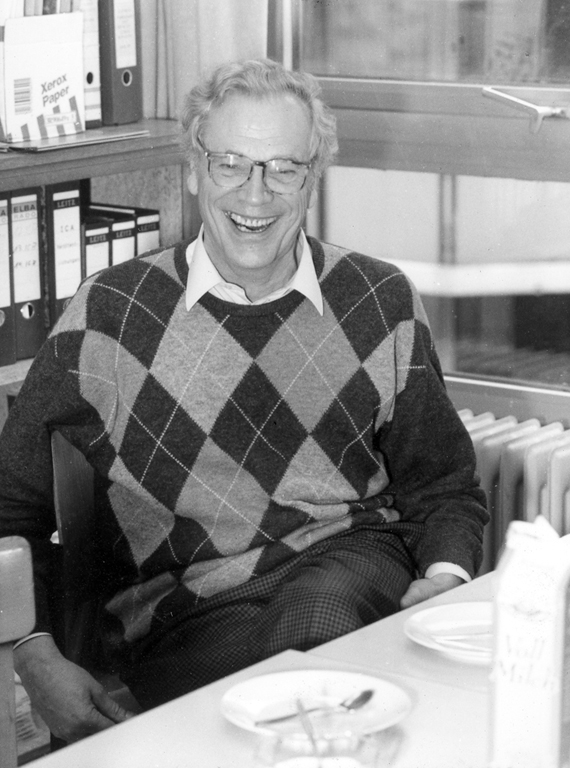
Unsere Gedanken sind bei seiner Frau Ingrid und seiner Familie.
Für alle Mitarbeiterinnen und Mitarbeiter,
für alle Ehemaligen des Instituts für Hörtechnik und Akustik der RWTH Aachen,
Prof. Dr. rer. nat. Michael Vorländer
Prof. Dr.-Ing. Janina Fels
Dr.-Ing. Lukas Aspöck
Acoustic investigations at Sagrada Familia
At the end of February this year, a team of the Institute for Hearing Technology and Acoustics conducted acoustic measurements at the renown Basílica de la Sagrada Família in Barcelona. The team of experienced acousticians consisted of current and former employees of IHTA and was led by Josep Llorca-Bofí and Michael Vorländer.
In the further course of the project, the measurement data was evaluated, processed and auralizations were generated. The study revealed Gaudi’s design challenges and opportunities and is a basis for future musical instruments design in different places and its liturgical use of the Sagrada Família Foundation.
- IHTA’s dummy head in the Basilica. Photo: Josep Llorca-Bofi.
- IHTA’s dummy head in the Basilica. Photo: Josep Llorca-Bofi.
- IHTA’s team coordinating the acoustic measurements. Photo: Gottfried Behler.
- IHTA’s dodecahedron measurement speaker was used in Basicila Familia to determine room impulse responses. Photo: Gottfried Behler.
- Microphones used in the central seating area of the Basilica. Photo: Gottfried Behler.
- IHTA’s team at the basilica. Photo: Gottfried Behler.






